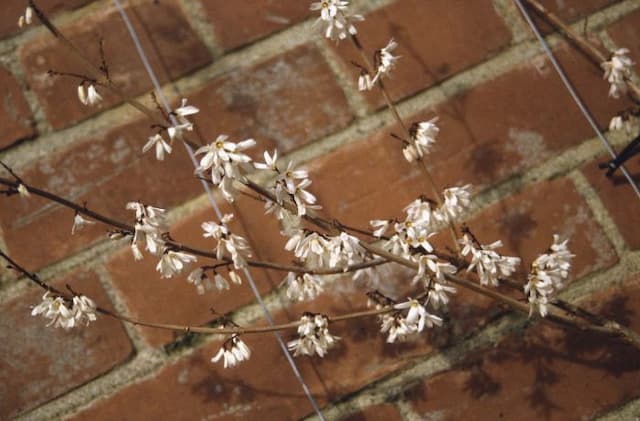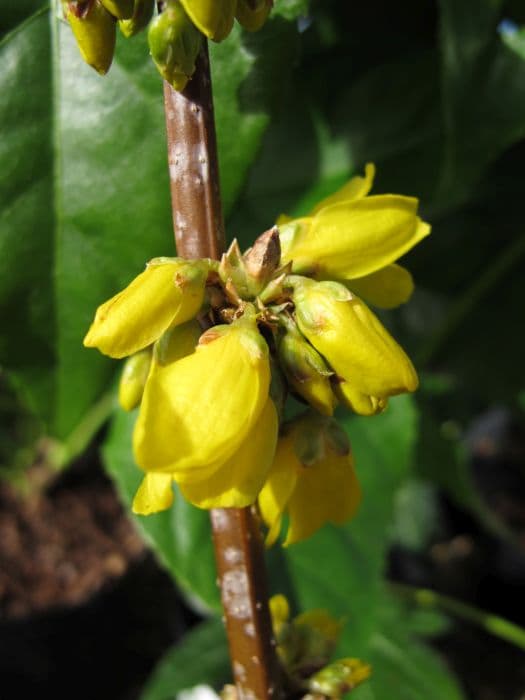Narrow-leaved ash Fraxinus angustifolia

ABOUT
The plant, commonly known as the Narrow-leaved ash, features a slender and elegant form. Its leaves are compound, typically comprising multiple leaflets arranged in an opposite fashion along the central vein. The leaflets are narrow, with a lance-like shape and a smooth, margin. Their color is a lush green during the growing season, turning to an array of yellow or golden tones before they fall off during the autumn season. The Narrow-leaved ash produces inconspicuous flowers that tend to be a purplish-brown color. These flowers appear before the leaves fully develop in the spring. Following the flowering period, the plant produces fruits that are long, narrow, and winged. These fruits, known as samaras, facilitate wind dispersal as they can carry the seeds over some distance when they fall from the tree. It is important to note that though the plant is adaptable to a range of soil types and conditions, its appearance can be influenced by the environment it grows in, which might affect the density of foliage and the overall shape of the crown, but without reference to its actual size. The Narrow-leaved ash has a bark that is gray and can become deeply furrowed as the plant ages, giving it a somewhat rough texture to the touch.
About this plant
 Names
NamesFamily
Oleaceae.
Synonyms
Narrow-Leafed Ash, Narrowleaf Ash, Raywood Ash, Claret Ash.
Common names
Fraxinus oxycarpa, Fraxinus parvifolia.
 Toxicity
ToxicityTo humans
Narrow-leafed ash is not typically recognized as a poisonous plant for humans. There's no widespread documentation of toxicity or poisoning symptoms from ingesting parts of this tree, such as its leaves or seeds. However, it's always wise to exercise caution and avoid eating parts of plants that are not known to be edible, as individual sensitivities can vary.
To pets
Narrow-leafed ash is not commonly known to be toxic to pets. There are no well-documented cases of poisoning in pets such as dogs and cats from ingesting parts of this tree. However, as with humans, it is generally advisable to prevent pets from consuming plants not intended for their diet to avoid potential gastrointestinal upset or other individual reactions.
 Characteristics
CharacteristicsLife cycle
Perennials
Foliage type
Deciduous
Color of leaves
Green
Flower color
Varies
Height
50 feet [15 meters]
Spread
40 feet [12 meters]
Plant type
Tree
Hardiness zones
6
Native area
Mediterranean
Benefits
 General Benefits
General Benefits- Shade provider: The narrow-leafed ash creates a good canopy that offers shade, making it suitable for parks and large gardens.
- Aesthetic appeal: With its narrow leaves and elegant form, it is often used for ornamental purposes, enhancing landscape design.
- Biodiversity support: The tree supports various wildlife species by providing habitat and food sources such as seeds for birds and small mammals.
- Soil improvement: Like many trees, the narrow-leafed ash can help to improve soil quality through leaf litter decomposition and root growth.
- Erosion control: With its strong root system, the tree helps to stabilize soil and prevent erosion, particularly along riverbanks.
- Wood production: The wood of Fraxinus angustifolia is valued for its toughness and elasticity, suitable for making tools, sports equipment, and furniture.
- Climate resilience: As a species native to various regions, it's adapted to different environments, making it resilient to climate variations.
- Carbon sequestration: By absorbing carbon dioxide from the atmosphere, the tree contributes to mitigating the effects of climate change.
 Medical Properties
Medical Properties- Anti-inflammatory: Fraxinus angustifolia may possess compounds that help reduce inflammation.
- Diuretic: The plant has been traditionally used to increase urine production, potentially aiding in the management of fluid retention.
- Antioxidant: It might contain antioxidants that can help in protecting the body from damage caused by free radicals.
- Laxative: There are indications that Fraxinus angustifolia may have been used for its laxative effects to relieve constipation.
- Antimicrobial: Some studies suggest the presence of antimicrobial properties, which could be effective against certain bacteria and fungi.
- Analgesic: The plant may have pain-relieving properties.
 Air-purifying Qualities
Air-purifying QualitiesThis plant is not specifically known for air purifying qualities.
 Other Uses
Other Uses- Fraxinus angustifolia, commonly known as Narrow-leaved ash, has been used in the production of musical instruments for its resonant wood qualities, particularly in the creation of electric guitar bodies.
- The wood of the Narrow-leaved ash is valued in joinery for making fine furniture and intricate woodworking due to its toughness and elasticity.
- In rural areas, the flexible young shoots of Narrow-leaved ash may be employed in traditional basket weaving practices.
- The tree's timber, being both durable and attractive, is sometimes used in veneer production for decorative panels and high-end automotive interiors.
- Landscape architects and garden designers plant Narrow-leaved ash for its slender profile and elegant foliage in urban parks and gardens.
- The ashes from burned Narrow-leaved ash wood can be used as a natural fertilizer due to its mineral content, which includes potassium carbonate.
- Leaves from the Narrow-leaved ash can serve as fodder for livestock, especially in times of scarce feed, although care must be taken due to potential toxicity in certain circumstances.
- Narrow-leaved ash saplings are sometimes employed as natural stakes in horticulture and tomato farming, leveraging their strength and availability.
- In some cultures, the leaves and bark have been used to dye fabrics a light-green color, utilizing the natural tannins and pigments present in the plant.
- The tree is occasionally grown for soil stabilization and reclamation projects because its extensive root system can help prevent erosion and enhance soil structure.
Interesting Facts
 Feng Shui
Feng ShuiThe Narrow-Leafed Ash is not used in Feng Shui practice.
 Zodiac Sign Compitability
Zodiac Sign CompitabilityThe Narrow-Leafed Ash is not used in astrology practice.
 Plant Symbolism
Plant Symbolism- Strength: The wood of the Narrow-Leafed Ash is known for its toughness and elasticity, making it symbolic of strength and resilience.
- Protection: Ash trees have traditionally been believed to have protective qualities, warding off evil spirits.
- Transformation: In some cultures, the ash tree is seen as a symbol of transformation and change, as it grows rapidly and transforms the landscape.
- Healing: The leaves and bark of Narrow-Leafed Ash have been used in traditional medicine, symbolizing healing and health.
- Connection: As a tree that often grows in groups and forms forests, the Narrow-Leafed Ash symbolizes connection with others and the environment.
 Water
WaterNarrow-leafed ash trees should be watered deeply and thoroughly to ensure the root system is well-hydrated, particularly during dry spells or in areas with low rainfall. Young trees require more frequent watering, about once or twice a week, with approximately 15 to 20 gallons per event to establish a strong root system. Mature trees can be watered less frequently, ranging from bi-weekly to monthly, with increased amounts of 20 to 30 gallons, depending on the weather and soil conditions. Overwatering should be avoided to prevent root rot. Adjust watering frequency based on the season, with less water needed in the cooler months and more in the growth season.
 Light
LightNarrow-leafed ash trees thrive best in full sunlight conditions, meaning they should receive at least six hours of direct, unfiltered sunlight each day. The ideal spot for these trees is in an open area, away from buildings or other structures that might cast shade on them. Full sun exposure is critical for the health and growth of the tree, as it ensures adequate photosynthesis and robust growth.
 Temperature
TemperatureNarrow-leafed ash trees are tolerant of a wide range of temperatures but perform best in areas where the climate is mild. They can withstand temperatures as low as 20 degrees Fahrenheit, which allows them to survive winter conditions in many regions. Ideally, they prefer temperatures that do not regularly drop below freezing. The optimal temperature range for these trees is between 60 and 80 degrees Fahrenheit to promote healthy growth.
 Pruning
PruningPruning is essential for narrow-leafed ash trees to remove dead or diseased branches and to maintain a strong, healthy structure. The best time to prune is in the late winter to early spring before new growth begins. It's recommended to prune the tree every two to three years, focusing on thinning out the canopy to allow for better air circulation and light penetration, which can reduce the risk of disease. Always make clean cuts and avoid over-pruning, which can stress the tree.
 Cleaning
CleaningAs needed
 Soil
SoilNarrow-leafed ash (Fraxinus angustifolia) thrives in well-drained soil that is rich in organic matter, ideally with a pH ranging from 6.0 to 7.5. A good mix would be loamy soil with compost and perlite to increase aeration.
 Repotting
RepottingThe Narrow-leafed ash doesn't typically require repotting as it is a large outdoor tree. If grown in a very large container, repotting every 3 to 5 years may suffice.
 Humidity & Misting
Humidity & MistingNarrow-leafed ash prefers moderate humidity levels but is tolerant of a wide range of conditions and adapts well to the outdoor environment's natural humidity.
 Suitable locations
Suitable locationsIndoor
Provide ample light; not ideal for indoor growth.
Outdoor
Plant in well-drained soil, full sun.
Hardiness zone
6-9 USDA
 Life cycle
Life cycleFraxinus angustifolia, commonly known as narrow-leaved ash, begins its life cycle with seed germination, which occurs in moist soil conditions, typically in the spring. After germination, seedlings emerge and establish a root system, with growth progressing to form a young sapling characterized by quick vertical growth. As the sapling matures, it develops a thicker trunk, branches, and compound leaves, entering its juvenile phase which can last several years until it reaches reproductive maturity. The mature narrow-leaved ash then produces flowers, typically in early spring before the leaves appear; these flowers are wind-pollinated and can give rise to samaras, winged fruits that disperse by wind. Once fertilized, the fruits develop seeds that fall to the ground to begin the next generation. The tree then enters a period of senescence in its later years, characterized by reduced growth and productivity, until it eventually dies.
 Propogation
PropogationPropogation time
Spring-early summer
Propogation: The most popular method of propagating the Narrow-leaved Ash, Fraxinus angustifolia, is through seed collection and sowing. The best time to collect seeds is in the late fall when they ripen. Seeds should be sown in winter or early spring after undergoing cold stratification, which simulates winter conditions and helps break the seed's dormancy. The cold stratification process involves mixing the seeds with a damp medium like sand and refrigerating them at around 34-40 degrees Fahrenheit (1-4 degrees Celsius) for 1-3 months. After stratification, seeds can be sown in a well-draining seed-starting mix, covered lightly with soil, and kept moist until germination occurs. Seedlings will typically require a few years of growth before they are ready for transplantation into their permanent location.









